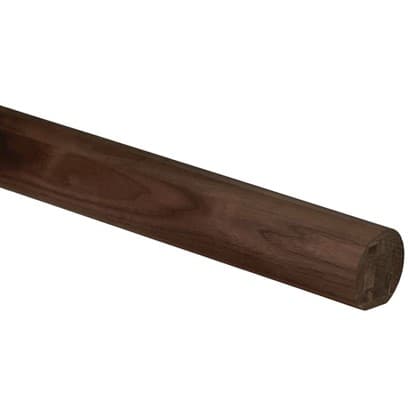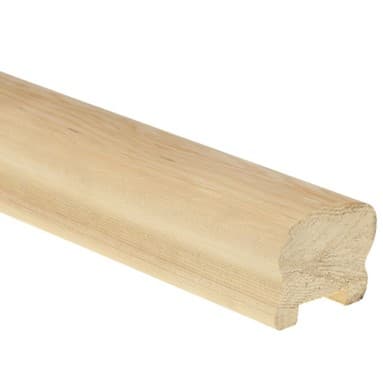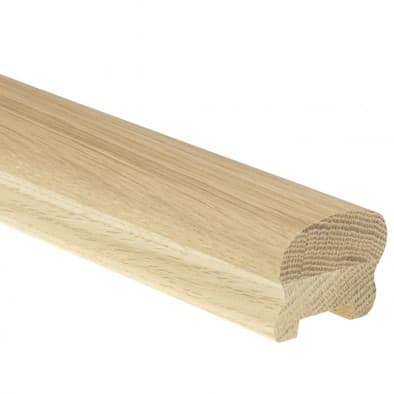Choosing the best wood for handrails – how does oak compare to different woods?
Oak is a hugely popular choice of wood for stair parts such as handrails due to its incredible durability and classic appearance.
If you’re not sure what type of wood to choose for your handrails, don’t worry. Here, we explore how oak compares to other types of woods that are used for handrails and how to choose the ideal type of wood for you.
Click on a link to jump to each section:
Read the key benefits of oak and why it is such a popular choice for handrails.
Find out how oak compares to other woods in terms of durability and strength, appearance, and price. Find out how oak compares to other woods in terms of durability and strength, appearance, and price.
Read what other factors you should consider when choosing handrails.
To find the style of oak handrail for you, shop our full range here.
Why choose oak handrails?
As you look for the best option for your staircase design, you will find that oak has a wide range of benefits. Oak is an incredibly durable material, which has superior strength. This means that it can withstand the daily use that wood stair parts tend to undergo. While it may be more expensive than other choices, oak has a unique classic appearance that can bring a touch of elegance to any home. With a wide choice of finishing options available, you can perfectly match a white oak handrail to the overall aesthetic of your home.
To find the style of oak handrail for you, shop our full range here.
How does oak compare to other types of wood?
Strength and durability
Oak is renowned for its powerful strength, and can cope with considerable force and wear and tear. As a hardwood, it has taken a long time to grow and develop - this translates into exceptional fortitude.
Hemlock, though not quite as durable as oak, is one of the strongest woods to choose from in terms of durability. Although a softwood, hemlock is very dense, which means that it is a very strong wood, ideally suited to use in handrails. Bear in mind; however, that oak can be more durable over time than hemlock.
Ash, on the other hand, is another very strong option - however it is less water-resistant than oak. Pine is also a fairly durable option, however can show scratches and dents. Pine has a close grain that makes it a considerably strong option.
Walnut is a premium hardwood and is an extremely strong option for handrails; however, it is not ideal if you have a small budget.
Recommended product
Walnut Round Mopstick Handrail 2.4mtr
- The mopstick handrail is an idea handrail to be mounted onto a wall. Decorative handrail brackets and end caps are available to complete the look.
- There is a 25mm flat on the underside of the rail.
- Walnut stair parts come unfinished and can be finished by painting, varnishing or waxing.
- Handrail Size: 2400mm x 54mm.

Appearance
Oak is generally light blonde to brown in colour and has a distinctive tiger-stripe grain without knots. Though a great option for a traditional home, it can span a wide array of styles, including contemporary.
Hemlock is similar to oak in that it is also knot-free, but its grain is more uniform, with a pale brown tone and black vein line. Find out more in our guide Oak vs hemlock handrails.
Pine, though noticeably slightly lighter than oak, is similar to oak in that it is one of the lighter woods. Oak does, however, tend to have a slightly darker, reddish colour, whereas pine ranges from light beige to yellow. Ash is also a great option if you are looking for a lighter wood like oak and is slightly lighter in colour and density than oak.
If you are looking for a darker wood for your handrails, some alternatives would be dark hardwood or walnut.
Recommended product
Pine HR Handrail 2.4mtr, 32mm Groove with Infill
The HR handrail has a 32mm groove, which will allow a 32mm spindle to be fitted into the groove. Infill/spacer comes pre-packed in with the handrail.
Pine stair parts come unfinished. They can be finished by painting, varnishing or waxing.
Handrail Size: 2400mm x 59mm x 56mm, with 32mm Groove and Infill.

What materials go well alongside oak, and how do you choose accessories?
Oak is a versatile shade of wood, and goes well alongside a large range of materials. However, the muted tone of chrome goes particularly well with paler shades of wood such as oak. Brushed nickel end caps and brackets also go well alongside warm hues of wood such as oak. Bear in mind that end caps and handrail brackets are only necessary for mopstick or standard ungrooved handrails that are being attached to the wall.
Read our full guide to choosing chrome end caps here.
End cap designs
When finding an end cap for your oak handrail, you have to make a decision between choosing a simple end cap design or a more decorative end cap design. Price is also a factor to consider when choosing a style – for example, often the smaller and simpler a design is – the cheaper the price. If you are looking for a minimalist style end cap to keep things simple, you can opt for an option such as our simple slim end caps.
If you are looking to dress up your handrail and add some drama, you can opt for a more decorative design, such as a filigree end cap, or a petal end cap design. An octagonal end cap design can also be a perfect solution if you are looking for a modest design that still adds a bit of decoration to your handrail system.
Handrail brackets for oak handrails
When choosing a handrail bracket, you can either opt for a simpler bracket in a neutral finish, or something a little more striking, such as a black wall bracket or a bracket in an ultra-contemporary style.
You will need at least two brackets to fit a handrail—one each at the top and bottom—and additional brackets to support the middle of the handrail. As a general rule, you should space handrail brackets no more than a metre apart.
You can choose between chrome, brushed Nickel, brass, or black and white handrails. The material you choose depends on the style and colours of your surroundings, and whether you want to choose a traditional or modern feel.
Shop our full range of handrail brackets here.
Price
Oak is an excellent choice for your home, and as oak handrails are one of the most expensive types of handrails on the market, they should be seen as an investment. They can be a great choice if you have bought a home and you are looking to improve the look and feel of a house you will be living in for many years to come. By investing in oak for your handrails, you can also be confident that your staircase won’t get damaged easily. Hardwoods such as ash, walnut and dark hardwood are also on the pricier end of the scale.
At the other end of the price range, the most affordable woods to choose for your handrails include hemlock, pine and white primed wood.
If you are looking for a strong alternative to oak that is less expensive, hemlock may be an ideal option. You can read more about how oak compares to hemlock here.
Recommended product
Hemlock Cottage Loaf Handrail 2.4mtr, 32mm Groove with Infill
The cottage loaf handrail has a 32mm groove, which will allow a 32mm spindle to be fitted into the groove. Infill/spacer comes pre-packed in with the handrail.
Hemlock stair parts come unfinished. They can be finished by painting, varnishing or waxing.
Handrail Size: 2.4mtr x 66mm x 45mm, with 32mm Groove and Infill

Other factors to consider when choosing handrails
As well as strength, durability, appearance and cost, there are some other essential factors to consider when choosing a handrail, such as the size of the handrail and the overall aesthetic you are going for.
You also need to make a choice between grooved handrails and ungrooved handrails. Grooved handrails are a perfect choice if you are wanting wooden or metal spindles, and they allow spindles to sit within the groove of the handrail. However, if you’d prefer to use glass panels, ungrooved handrails or glass grooved handrails would be a better choice. You can view our full range of handrails here.
Find out more about the differences between grooved and ungrooved handrails here.
There is also a range of different designs to choose from – popular options include cottage loaf, HR and traditional. The right design for you depends on whether you are looking for more of a modern design or a traditional, classic design. As a popular type of wood for handrails, oak is available in a wide variety of designs.
Recommended product
Oak Cottage Loaf Handrail 2.4mtr 32mm groove with infill
- Oak Cottage Loaf Handrail 2.4mtr 32mm groove with infill
- The Oak cottage loaf handrail is part of the Oak range of modern and traditional stair parts.
- The HR handrail has a 32mm groove, which will allow a 32mm spindle to be fitted into the groove. Infill/spacer. comes pre-packed in with the handrail.
- Oak stair parts come unfinished and can be finished by painting, varnishing or waxing.
- Handrail Size: 2400mm x 66mm x 45mm, with 32mm Groove and Infill.

Find out more about the different handrail designs here.
Combining oak and glass
Combining glass and oak is a versatile way to achieve a modern yet classic style for a glass staircase. Using a warm shade of wood such as oak creates a traditional feel, while glass keeps the overall effect minimalist, stylish and up-to-date. There are several advantages to mixing materials, such as glass and wood, when designing your new staircase hardware.
First and foremost, using glass panels instead of wooden spindles allows a solid finish, whilst still enjoying the traditional, natural feel of using timber.
Glass panels can also let the light through even better than spindles, making the staircase seem brighter and more open. This effect can allow light from upstairs windows to radiate downstairs, creating an overall light and airy feel.
Solid glass panels can also sometimes be safer than using wood, particularly if you have young children who might attempt to wiggle through gaps between wood spindles. Glass panels are made from toughened, tempered glass, making them safe and effective choices for any home. Read our full guide to glass balustrades here.Read our full guide to glass balustrades here.
To view your full range of options, shop our selection of oak handrails today.
Frequently asked questions
What is the best paint for wooden stairs?
When it comes to wooden stairs, it is important to use a primer which you can then paint over with semi-gloss paint. This tends to be harder wearing than other paints.
Can you paint over stained oak without sanding?
While it is possible to paint over stained wood without sanding, the stain may bleed through and cause streaking.
How do you paint an oak handrail white?
It is possible to paint an oak handrail white, but sanding and preparing the wood is an essential part of this process. You will need to take extra care to make sure this is done to a high standard, to ensure that no colour comes through in the finished result.
How do you refinish an oak handrail?
To refinish an oak handrail, you will need to strip the wood before preparing and priming it. Then you can stain and finish the wood to your own aesthetic tastes.
Should you paint or stain your handrail?
Paint is a great way to freshen a handrail or balustrade, but staining tends to last for longer and be more resilient over time.
Are you still unsure how to select oak handrail designs or materials? Contact Jackson Woodturners today.
